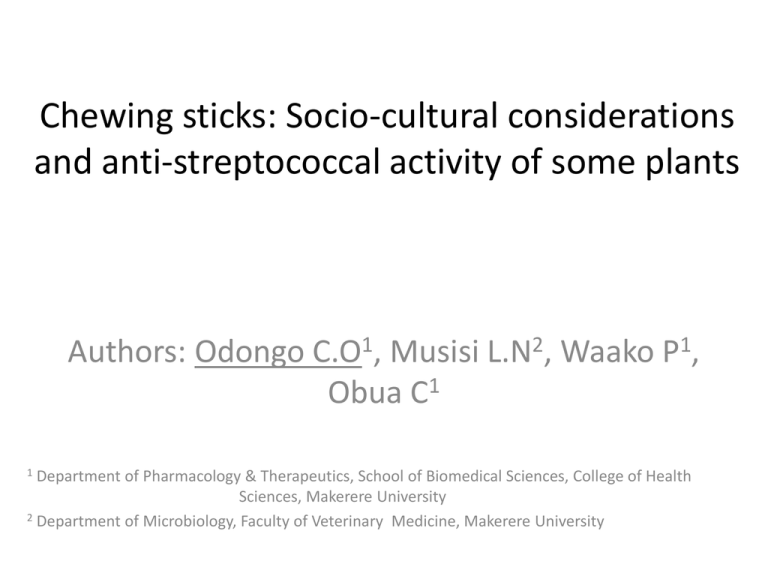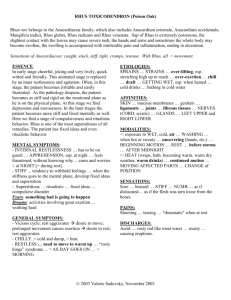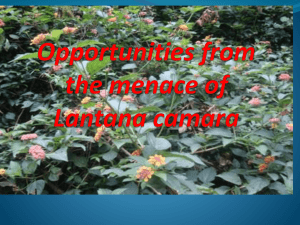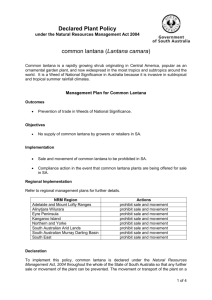Traditional Practices and Antibacterial Activity of Rhus vulgaris and
advertisement

Chewing sticks: Socio-cultural considerations and anti-streptococcal activity of some plants Authors: Odongo C.O1, Musisi L.N2, Waako P1, Obua C1 1 Department of Pharmacology & Therapeutics, School of Biomedical Sciences, College of Health Sciences, Makerere University 2 Department of Microbiology, Faculty of Veterinary Medicine, Makerere University Background • Dental self-care is poor and plaque-associated dental diseases are widespread in Uganda (Okullo, 2004; Wandera & Ntwatwa, 2003; Muwazi et al; 2002, Tirwomwe et al; 1987) • Professional dental care services are scarce and expensive, Needs of the majority are unmet – limited professionals (National Oral Health Policy, 2007) • Need to explore and develop affordable, yet effective methods of disease prevention • Good oral hygiene (with plaque removal) is essential in the prevention of dental diseases • Traditional toothbrushes (chewing sticks) have been in use for ages and clinical studies have demonstrated their efficacy (Almas & Al-Zeid, 2005; Al-Otaibi et al., 2003; Darout et al., 2000; Aderinokun, 1999) • Some chewing sticks contain compounds with antibacterial or anti-inflammatory activity (Prashant et al., 2007; Ndukwe et al., 2005; Ooshima et al., 2000; Hu et al., 2000; Almas, 1999; Sote & Wilson, 1995) • No studies of this kind have been done on local chewing sticks despite reported use (Katende et al., 1998; Kokwaro, 1976, Eggeling, 1952) Aims of the study 1. Identify and document plants from which chewing sticks are prepared in a community in Buganda 2. Describe the preparation and use of chewing sticks 3. Evaluate antibacterial activity of aqueous extracts of two of the most reported plants against wild cultures of Streptococcus mutans. Methods and Materials Study design: Qualitative study of mixed design • community survey using Key Informant Interviews, • field walks and laboratory experimental assays Study sites and selection method • 1st: Sango & Buwanda villages (Mpigi district), conveniently selected • 2nd: Makerere University, Depts. of Pharmacology & Therapeutics (CHS) and Microbiology (FVM). Selection of Key informants • Local Council 1 Chairperson: permission and recommend “Village Elders” as key informants. Plant collection and identification • Plants identified and collected with aid of Key Informants • Demonstrations of chewing stick preparation and use • Vouchers prepared & stored in field, approx. 500g of branches of Rhus vulgaris & Lantana trifolia taken for analysis • Taxonomic identification done by two independent botanists, deposits at herbarium (Makerere University) Processing & formulation of standard test solutions • Method of Prashant et al, 2007, (& Almas, 1999). • Briefly: 2 day sun-dried sticks crushed, weights of 5g, 10g, 50g, • @ soaked in 100ml of de-ionised water at 4o C for 48 hrs. • Filtrates of 5%, 10%, 50% obtained. Modifications: • Crushed fresh, Open air-dried for 2 weeks in cool shade, • Only 50g used, Extraction (48 hrs at 2o C) • Filtrates passed thru bacterial membrane filters (0.45 µm pores, Ministart®, UK). Assumption: extraction process progressed until there was saturation of the aqueous phase Isolation of Strep. mutans • Dental plaque - transported to lab in Stuart’s medium (Sterilin®, COPAN innovations, UK) • Isolation on Mitis-Salivarious agar (Harold & Johannes, 1975). • Pure plates prepared and confirmed with biochemical tests. Antibacterial assays • Agar-well diffusion used on Blood agar (Baker & Silverton, 1985). • 24 hr old culture spread on three plates using sterile cotton buds, 4 wells (4 mm deep) made onto @ plate using borers (5 mm diameter). • Wells were labeled and filled sequentially using separate sterile o pipette tips, incubated aerobically at 37 C for 48 hrs. • Experiments set in triplicate , run concurrently. • Extracts considered active if inhibition zone was 8mm or more (Baker & Silverton, 1985) Data Analysis: • Qualitative Content Analysis (Abramson & Abramson, 1999), • MS Excel program (bioassay results) RESULTS Table 1: Socio-demographic characteristics of key informants from Sango and Buwanda villages, Mpigi district Characteristic Male Female Mean age (yrs) 55 (n=12) 59 (n=9) Subsistence farmer 8 8 Commercial farmer 1 Office clerk b 3 Teacher b 1 Policeman b 1 Herbalist 1 3 Retail shop keeper 5 1 Consent to audio records 5 1 Occupation a a: some key informants had multiple occupations b: these were retired civil servants 12 Table 2a: Details of plants identified as sources of chewing sticks in Sango and Buwanda villages, Mpigi district Botanical name Family Parts used Voucher / accession no. Rhus vulgaris Meikle Anacardiaceae Branch 37789 Mangifera indica L. Anacardiaceae Branch 37794 Draceana fragrans (L.) Ker Gawl Agavaceae Stem 37793 Lantana trifolia L. Verbenaceae Branch 37792 Acacia hockii De Wild Fabaceae Branch 37791 Citrus sinensis (L.) Osb. Rutaceae Branch 37790 Citrus limonia (L.) Osb. Branch 37788 Rutaceae Table 2b: Names of chewing stick plants in some local dialects in Uganda Scientific name Luganda Lusoga Luo Runyankore Lugbara Ateso Mangifera indica Muyembe Muyembe Muyeme Aeme Omweembe Mombe Emwembe Draceana fragrans Oluwanyi Oluwanyi Lantana trifolia Kayukiyuki Kasekeranyonyi Kapanga Belwinyo Bel awele Omushekyera Omuhuuki Obolokoanya Amwee Elantaana Acacia hockii Kasaana Kasone Oryang Rugando Ali Ekisim Rhus vulgaris Akakansokanso Kakwansokwanso Busojole Awaca Atyendwinyo Omukanza Obukaanja Abilika Epwatet Ewaya Citrus sinensis Omuchungwa Omuchungwa Macungwa Mucunguwa Omuchungwa Citrus limonia Ennimu Ennimu Lemun Ndimu Endimu Mugorogoro Omugorora Source: Katende et al., 1998 & Katende et al., 1999 14 Table 3: Frequency table showing percentage reports of use of various chewing stick plants Plants reported as chewing Number of times reported stick sources (n=21)q Percentage reports (%) Rhus vulgaris 16 76.2 Lantana trifolia 12 57.1 Mangifera indica 9 42.9 Enzzo f 9 42.9 Cassia hockii 7 33.3 Draceana fragrans 6 28.6 Citrus limonia 5 23.8 Citrus sinensis 2 9.5 q: most plants were reported more than once by various key informants f: name in local dialect as it was not possible to obtain sample for identification 15 Why these plants? • These plants yield chewing sticks with: 1. Sufficient brush-like bristles 2. Resilient to mechanical stress of tooth brushing 3. Palatable • High fiber content confers the firm & fibrous character common to all • Users learnt of these plants (preparation & use) at an early stage in life • No medicinal value was claimed by users Are these plants available? • The right chewing-stick plants have drastically reduced in number within the domestic environs (esp. Rhus vulgaris, Mangifera indica, Cassia hockii and Enzzo) “Kakwansokwanso ta kya labika wano kumpi, aba mwetaaga ba mujja mu tale” Reasons: 1. Rhus vulgaris roots boiled and drunk to treat abdominal pain in pregnant women (Mubiru et al., 1990; Katende et al., 1998) and hypertension and sugar disease (Mwebaza et al., 2005) 2. Source of wood fuel 3. Clearance of wild vegetation for habitation or agricultural land (population pressure) Preparation of chewing sticks • Common method of preparation • Stems and branches (0.5-1.0 cm) cut off, bark removed, • One end chewed into a soft brush-like fringe Usage and storage of chewing sticks • Pressed against teeth & moved thru fine vertical & horizontal motions, a tooth at a time so as to avoid gum injury • Good manual dexterity & plenty time required to use correctly and effectively. Used once or twice daily • Stored anywhere safe from human or animal contact (e.g. stuck between tree branches, grass thatched roofs, above door panels, inside ventilator bricks, top of cupboards or wardrobes etc) Reasons for use of the chewing stick: 1. Availability, cost free, 2. Does not require toothpaste, 3. Better oral access, 4. Avoids gum injury, 5. Synthetic bristles fall into the throat & cause cough Reasons for use of the synthetic toothbrush: 1. Scarcity of chewing-stick plants (availability of synthetic toothbrushes), 2. Durability & better performance of the synthetic toothbrush, 3. Lack of time (elaborate preparation of chewing sticks), 4. Gum injury (there was a contradiction), 5. The chewing stick is an outdated tool. Table 4: Summary results of inhibition diameters of Rhus vulgaris and Lantana trifolia against Strep. mutans on 5% sheep blood agar at 48 hrs incubation Extract / Control Mean diameter (mm) 95% confidence limits of mean (± SD) n=3 Rhus vulgaris Lantana trifolia 24.33 (± 0.58) 22.89-25.76 14.17 (± 0.29) 13.45-14.88 Benzyl penicillin De-ionized water 30.67 (± 0.29) 30.45-31.88 0 - Plate 1: Blood agar plates showing inhibition zones on labeled wells of Rhus vulgaris, Lantana trifolia, benzyl penicillin and deionized water Conclusions: • Rhus vulgaris and Lantana trifolia chewing sticks are most commonly used in oral care along with synthetic toothbrushes • Their extracts are active against Streptococcus mutans • Preparation and use is uniform within this community, not associated with rituals or cultural beliefs Recommendations • Further studies to establish active principles • Public awareness to promote conservation Lantana trifoila Rhus vulgaris A key informant demonstrates preparation of a chewing stick from the stem of Draceana fragrans Acknowledgements • Gulu University • Laboratory staff of Pharmacology, Pharmacy and Veterinary microbiology, (Mak.) • Dr. Namaganda Mary (Department of Botany, Makerere University) • Dr. Katuura Esther (Natural Chemotherapeutics Research Laboratory) • Mr. Aloysius Lubega (translator & village guide)









